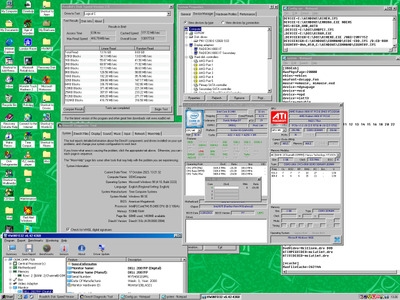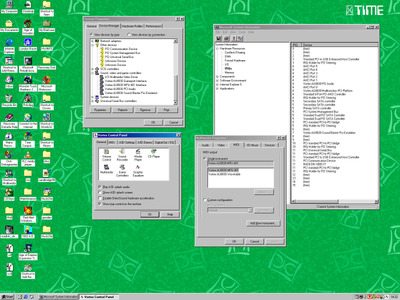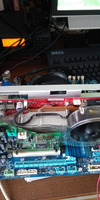Reply 20 of 56, by fosterwj03
gmaverick2k wrote on 2023-10-16, 20:56:fosterwj03 wrote on 2022-02-05, 15:18:My ultimate Win98 build has a Core i5-3750, Intel B75 motherboard, Radeon x800 XL, Via SATA card, Via USB 1.1/2.0 card, Realtek NIC, and Sound Blaster Live! Value. Rock stable, and plays games quite well. It has no DOS sound compatibility, but I have other systems for DOS.
I prefer the x800 XL to my GeForce 6800. The Radeon is much faster in Win98. The GeForce drivers also have all sorts of stability issues.
Do you have a guide for this. Hitting a wall trying this with b75m, x800xt, I5-2400, 1gb ddr3, SSD -_-
I don't really have a guide per se. Retro rockets take a lot of trial and error to get just right. Shoot, I recently spent a week trying to figure out why an Audigy 2ZS wouldn't work right on my B75 motherboard when a Sound Blaster Live! worked just fine. In the end, I gave up and decided to use an Audigy 1 with Windows Me/98SE and the Sound Blaster Live! with Windows 98FE. Oddly, the Audigy 1 VXD drivers caused all sorts of problems with Windows 9x on this platform while the WDM divers worked perfectly.
Anyway, here's a general order I perform on a fresh install:
1) Key BIOS settings:
- CPU Cores: Auto
- Memory Timings: XMP
- Primary Video: PCIE
- Drive controller: AHCI
- USB 2.0: Enabled
- USB 3.0: Smart Auto
- Onboard LAN: Disabled
- Onboard Audio: Disabled
- Serial Port(s): Disabled
- Parallel Port: Disabled
2) Partition and format the SSD. I recommend a primary FAT32 partition no larger than 64GB (you can make larger partitions, but I've had problems installing to larger ones). I create two FAT32 partitions (with an extended partition with a single logical drive) on the SSD. I put all of the installation disks, drivers, software, and media I use on the second partition using a second computer.
3) Boot the target computer using a Windows 98 boot CD. If the primary partition needs a format for a clean install, I run the "FORMAT C: /Q" command. Keep the CD in the drive.
4) Change the command prompt to the drive and folder of the Windows 98 installation files. Run the "SETUP /P i" command (you can use other switches as well) to prevent Windows 98 from installing the ACPI drivers that likely cause boot failures. Run through the first round of installation until the first reboot.
5) Optional for greater than 1.5GB of RAM. Boot again from the CD. Change the command prompt to the C:\Windows\Command directory and run "EDIT C:\WINDOWS\SYSTEM.INI". In the editor, move the cursor to the [386Enh] section. Add the line "MaxPhysPage=30000". Save the file and exit the editor. This will allow Windows 98 to boot with more than 1.5GB of RAM. Alternately, you can run Rloew's 4GB RAM patch at this point, but I do that later. Reboot without the CD in the drive.
6) Complete the Windows 98 installation. You should eventually get to the Windows desktop. I check the Device Manager first thing to see what hardware the installation program found.
7) Run the "Add/Remove Hardware" wizard, and manually install Rloew's AHCI driver from the "Hard Drive Controllers" section of the wizard. If your board has 6 SATA ports, use the 6-port driver. Otherwise use the 4-port driver.
8 ) If you had the "PCI Bus" listed in the Device Manager, skip to the next step. If you didn't, restart the "Add/Remove Hardware" wizard. Manually install the PCI Bus driver from the "System Devices" section. Complete the wizard, and Windows will begin detecting PCI devices. Feel free to install any devices for which you have drivers except sound and graphics.
9) Open the Device Manager, and "Update Drivers" for any remaining devices except the sound card and Graphics card. Keep in mind that some devices (like the SMBus and Intel Management Engine in my case) may not have drivers. The computer will function properly without them.
10) Run the NUSB 3.3 package for Windows 98FE or the NUSB 3.6 package for Windows 98SE. If NUSB doesn't start the hardware wizard, go back into Device Manager to manually install the drivers for "Standard Enhanced USB Controller" for all of the listed USB devices. In my case, the USB 3.0 ports are listed twice and only one of the entries works with the USB 2.0 drivers. Also, the NUSB drivers require USB 1.0 drivers even though the computer may not have any USB 1.0 controllers. I install "Standard USB Controller" drivers to the USB 3.0 ports just to force USB 1.0 drivers to install on the hard drive.
11) Install DirectX 9.0b (required for the ATI X800 series).
12) Run the sound card installation program. I like the base programs for my Sound Blasters, so I run the main install program for both drivers and apps. I let the program handle both.
13) Install IE 5.5 or IE 6.0 SP1. The ATI control panel uses IE elements, so it works best to have an updated copy of IE installed.
14) Install the Catalyst Drivers and Control Panel 6.2 package. If Windows doesn't detect the graphics card after the next reboot, change the resolution and color depth in the Display Properties and allow the computer to reboot. If that doesn't work, you might need to boot into Safe Mode and remove all of the graphics entries in Device Manger. Reboot again in this case and let the hardware wizard detect the X800.
15) Exit Windows to the DOS prompt. Install Rloew's 4GB RAM Patch if desired. After installing that, I change the line in SYSTEM.INI to "MaxPhysPage=70000" to use 1.7GB of RAM for stability.
15) Complete any additional software installations and personalize Windows.
That's my basic procedure. I mess with my hardware a lot, so I end up troubleshooting quite a bit. I still execute these steps in roughly the same order. Good luck.
Edit: I should also note that my B75 motherboard won't boot Windows 9x with any connected USB devices (including the keyboard and mouse) after I install the NUSB package. I haven't figured out why yet. I make sure to unplug them before boot or after a reboot, and then I plug USB devices back in once I get to the Windows desktop. Weird!



